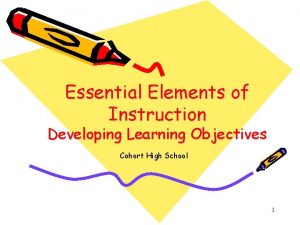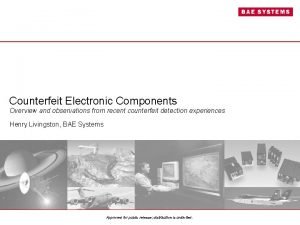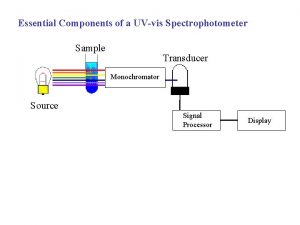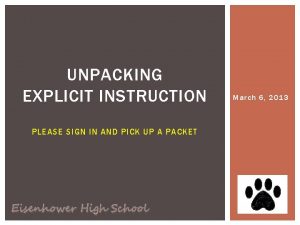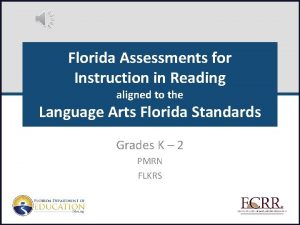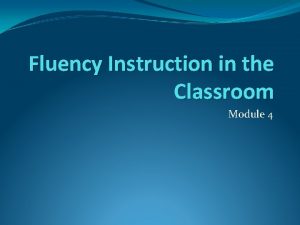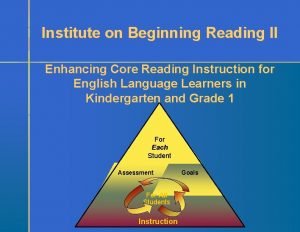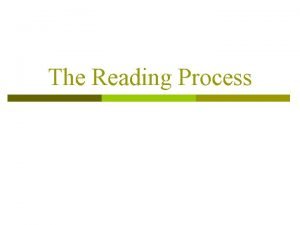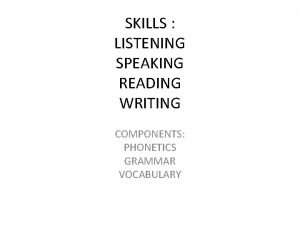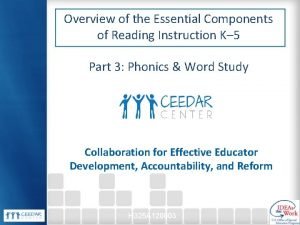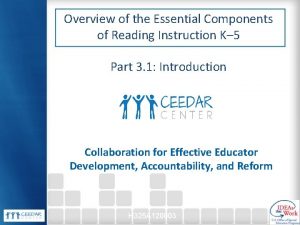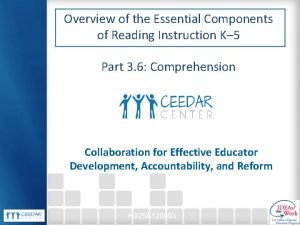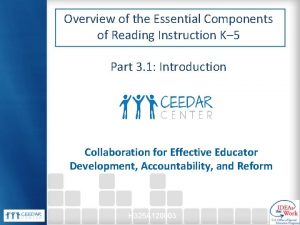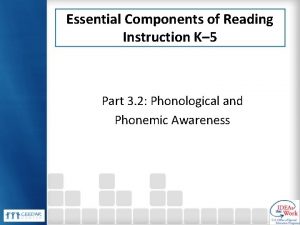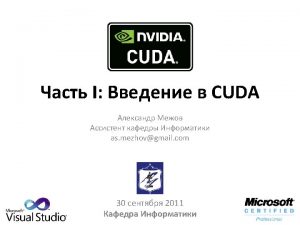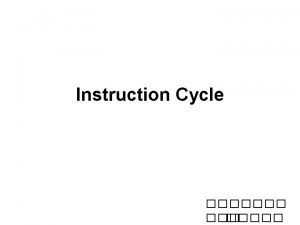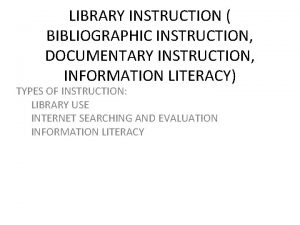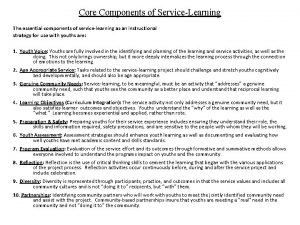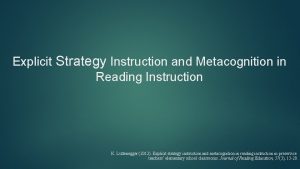Overview of the Essential Components of Reading Instruction








































































- Slides: 72

Overview of the Essential Components of Reading Instruction K– 5 Part 3. 6: Comprehension A special thanks to the Meadows Center for Preventing Education Risk at the University of Texas at Austin for permission to use and adapt material from a module created by the Higher Education Collaborative: Foundations of Reading Instruction. © 2009 University of Texas System/Texas Education Agency www. meadowscenter. org H 325 A 120003

Essential Components of Reading Instruction K– 5 Part 3. 6: Reading Comprehension for Primary Students, Grades K-3


Objectives • Define comprehension instruction • Discuss what the research says • Observe and practice evidencebased activities • Study an instructional plan

What Is Reading Comprehension? Comprehension is the process of simultaneously extracting and constructing meaning through interaction and involvement with written language. RAND Reading Study Group, 2002

Comprehension Strategies • What are evidence-based comprehension strategies? • When are they taught? • How are they taught?

Common Core Standards 10. Read and comprehend complex literacy and informational texts independently and proficiently. National Governors Association Center for Best Practices & Council of Chief State School Officers. (2010). Common Core State Standards. Washington, DC: Authors. http: //www. corestandards. org/

Common Core Standards In your small group: 1. Highlight verbs that require comprehension of text 2. Note the alignment across grade levels 3. Highlight verbs across grade levels

Good Readers • Use strategies before, during, and after reading • Are active readers • Have clear goals for reading • Preview the text & note text structure • Apply strategies selectively Duke & Pearson, 2002

Good Readers continued • Ask themselves questions • Construct, revise, and question • Integrate prior knowledge • Note the author, context, bias • Monitor their understanding • Evaluate the text’s qualify and value Duke & Pearson, 2002

Evidence-Based Practices • Teach reading comprehension strategies early, even before students begin to read • Teach multiple reading strategies simultaneously • Reutzel, Smith & Fawson, 2005

Teach Comprehension…. • Directly • Explicitly • Systematically • Before, During & After Reading Archer & Hughes, 2011; Connor et al. , 2014; Coyne et al. , 2007; Gersten et al. , 2001 ; Moats, 2005; RAND, 2002; Vaughn & Linan. Thompson, 2004

#1: Use of Strategies • Deliberate efforts to understand what is being read (p. 11) • Evidence-based strategies include: o Activating prior knowledge o Making predictions o Questioning o Visualizing o Self-monitoring o Making inferences o Summarizing Fisher & Frey, 2008; Mason, 2004; Mc. Keown et al. , 2009; Shanahan et al. , 2010; Vaughn et al. , 2000

#2: Text’s Organizational Structure • Teach students a variety of text structures: – Narrative • • Fiction Historical fiction Biographies Fables – Informational • • • Expository Descriptive Argumentative Persuasive Procedural Shanahan et al. , 2010

#3: High-Quality Discussions Students should: • Argue for or against points • Draw conclusions and inferences • Think deeply about text • Ask question. • Learn to lead their own discussions Shanahan et al. , 2010

#4: Select Texts Purposefully • Wide range of text structures. • Rich in depth of ideas and information. • Appropriate level of difficulty. • Support goals of the lesson. Hiebert, 2012; Shanahan et al. , 2010

#5: Engaging & Motivating Context • Choose texts that are motivating. • Model the importance, purpose, and benefits of reading. • Convey how strategies will help students learn. • Provide choices. • Provide opportunities to work with peers. Shanahan et al. , 2010; Wigfield & Guthrie, 2000

Before Reading Strategies • Set a purpose for reading • Provide questions and connections to the text to increase student engagement • Make predictions • Pre-teach key vocabulary and concepts • Link to students’ background knowledge • Teach text features and structures Adams, 1990; Graves et al. , 2001; Vaughn & Linan-Thompson, 2004

During Reading • Model thinking aloud, making your thinking visible • Provide guiding questions • Summarize main ideas of paragraphs • Revisit predictions • Sequence the events • Go back to text to locate evidence Vaughn & Linan-Thompson, 2004;

After Reading, Students. . . • Ask different types of questions • Generate questions from the text • Reflect on predictions • Summarize the text • Find evidence in the text for their answers Shanahan et al. , 2010; Vaughn & Linan-Thompson, 2004;

Support Strategy Instruction • Provide concrete examples • Use think-alouds • Provide explicit and systematic instruction • Actively engage students Birsh, 2011; Carnine, 2006; Coyne et al. , 2007; Duke & Pearson, 2002; Dycha, 2012; Shanahan et al. , 2010

Examples of Strategies • Make connections • Create mental images • Determine importance and summarize • Make inferences and predictions Children’s Learning Center, 2009; Dycha, 2012

Notable Quote Although we may highlight or focus on one strategy at a time to help clarify and make the strategy explicit, we need to ensure that our students know that strategies don’t happen in isolation. We use them automatically, interchangeably and usually, we use more than one at a time. Children’s Learning Institute, 2009, p. 27

Making Connections Student-friendly definition: When we are reading, sometimes the book reminds us of something in our background. When something in a book reminds us of our lives, we call that making connections. Connections help us to better understand what we read. Dycha, 2012

Concrete Example

Think-Aloud: Making Connections • Embed your think-aloud. • Make it short but relevant. • Do NOT make your statement the focus of a discussion! Stick to the text. Collins-Block et al. , , 2004; Collins-Block & Mangieri, 2003; The University of Texas Health Science Center, 2008

Your Turn • Preview a text. • Good to model making connections? • Helpful background knowledge? • Choose a place to model; tag it. • Practice with your partner.

Creating Mental Images Student-friendly definition: a picture that you make in your mind of something you are reading about to help you understand the story better. Hibbing & Rankin-Erickson, 2003; Keene & Zimmerman, 2007; Taylor et al. , 1999; Tovani, 2000

Your Turn • Discuss ways to introduce creating mental images using concrete examples. • Be prepared to model.

Think-Aloud: Creating Mental Images LISTEN! Chrysanthemum K. Henkes (1991), pg. 20

Your Turn • Choose an appropriate text • Tag a think-aloud stopping point • Practice modeling • Be prepared to share

Determine Importance & Summarize Student-friendly definitions: • Determine importance: after reading, decide what in the text matters. • Summarize: make a short statement providing the important information and not too many details. Harvey & Goudvis, 2007; Mc. Gregor, 2007

Concrete Example Camping Checklist 1. 2. 3. 4. 5. 6. 7. sleeping bag hair dryer flashlight men’s suit tent water curling iron

Your Turn Discuss: • Concrete ways to explain determining importance and summarizing • Be prepared to model

Think-Aloud Determine Importance & Summarize LISTEN! Chrysanthemum K. Henkes (1991), pg. 11 -13, 22

Your Turn • Choose an appropriate text • Tag a think-aloud stopping point • Practice modeling • Be prepared to share

Making Inferences & Predictions Student friendly definitions; • Making inferences: using clues in the story and what we already know to figure out things the author does not tell us directly • Making predictions: using what you already know to make statements about what you think will happen

Concrete Example My friend came to see me, smiling and holding a picture. I knew she was happy about the birth of her first grandchild. How did I know?

Facts Supporting My Inference • She told me her son and daughter-in-law went to the hospital last night. • I knew their baby was due soon. • She was smiling. • She had a picture of a baby boy. Inference: My friend was happy about the birth of her grandson.

Your Turn • Create concrete examples • Be prepared to share

Think-Aloud: Making Inferences and Predictions LISTEN! Chrysanthemum K. Henkes (1991), pg. 24

Your Turn • Choose an appropriate text • Tag a think-aloud stopping point • Practice modeling • Be prepared to share

8 -Step Comprehension Routine 1. Anchor experience 2. Explicit explanation 3. Touchstones and anchors 4. Planned thoughtful teacher questions before, during, and after reading Children’s Learning Center, 2009; Dycha, 2012

8 -Step Comprehension Routine continued 5. Teacher modeling with think-alouds 6. Whole-group guided practice 7. Small-group instruction and guided practice 8. Independent use of the strategy with accountability Children’s Learning Center, 2009; Dycha, 2012

Planning Lessons Matching Text & Strategy Choose an appropriate text that: • Can be read in one to two lessons • Has three logical think-aloud points • Allows students to think, turn, talk • Is grade appropriate

Planning, continued 1. 2. 3. 4. 5. 6. Read the book Select 3 stopping points Use sticky notes to mark Write your think-aloud Complete a lesson plan Plan differentiation activities

Essential Components of Reading Instruction K-5 Part 3. 6: Reading Comprehension for Primary Students, Grades 3 -5

What Is Reading Comprehension? Comprehension is the process of simultaneously extracting and constructing meaning through interaction and involvement with written language. RAND Reading Study Group, 2002

Evidence-Based, Efficacious Comprehension Strategies • • • Monitor own comprehension Use graphic and semantic organizers Answer and generate questions Recognize text structure Summarize text Use evidence from text to support conclusions Paris & Stahl, 2005; Pressley, 200; Rand, 2002

Teaching Strategies 1. 2. 3. 4. 5. 6. Develop background knowledge Discuss the strategy Model and explain the strategy Learn and remember the strategy Engage in collaborative practice Engage in independent practice

Strategies for. . . • Before reading • During reading • After reading

Collaborative Strategic Reading (CSR) • A cluster of strategies • Promotes content learning, language acquisition, and reading comprehension • Includes ELLs and students with disabilities • Effective with expository text Klinger et al. , 2012

CSR, continued • Cooperative learning • All content areas • Active teacher monitoring • Actively engaged students Klinger et al. , 2012

Strategic Reading With CSR

Before Reading: Previewing • Use background knowledge • Identify key words and concepts • Make predictions • Identify genre and text structure Klinger et al. , 2012

During Reading: Click & Clunk • Recognize clunks—unfamiliar words or concepts • Apply fix-up strategies Clunks Words or concepts that cause comprehension Difficulties and do not make sense Klinger et al. , 2012 Clicks When students understand text

Clunk Cards Reread the sentence with the clunk and look for key ideas to help you figure out the word Reread the sentences before and after the clunk, looking for clues Look for a prefix or suffix in the word that may help. Break apart the word and look for smaller words that you know.

During Reading: Get the Gist 1. Who or what is the paragraph about? 2. What is the most important thing about the “who” or “what”? 3. State the main idea in 10 words or fewer. Klinger, J. , Vaughn, S. , Boardman, A. , Swanson, E. , 2012

After Reading: Wrap-Up • Formulate questions • Identify the most important ideas • Summarize what was learned Klinger, J. , Vaughn, S. , Boardman, A. , Swanson, E. , 2012

Cooperative Groups • Teach students to work cooperatively – Model learning roles – Provide guided practice – Provide cue cards • Assign groups and roles Klinger, J. , Vaughn, S. , Boardman, A. , Swanson, E. , 2012

CSR: Learning Logs • Each student completes: o Before o During o After • Serves as a progress-monitoring record Klinger, J. , Vaughn, S. , Boardman, A. , Swanson, E. , 2012

Teachers. . . Before implementing CSR: • Teach strategy • Model and provide practice • Have students practice roles and responsibilities of group During CSR: • Circulate and monitor • Provide scaffolding Klinger, J. , Vaughn, S. , Boardman, A. , Swanson, E. , 2012

Let’s Try CSR! 1–Leader 2–Clunk expert 3–Gist expert 4–Question expert 5–Encourager 6–Timekeeper

CSR Role Descriptions • Leader: guides group about what to read or which strategy to use • Clunk expert: figures out difficult words or concepts (i. e. , clunks) using the fix-up strategies • Gist expert: guides the development of a gist statement that includes most important ideas (10 words or less)

CSR Roles, continued • Question expert: leads the development of meaningful questions and varying types • Encourager: provides positive feedback and encourages all students to participate • Timekeeper: keeps the pacing brisk and the group from becoming bogged down

Preview & Predict • Preview: o Title, pictures, headings, charts, and graphs o Brainstorm prior knowledge • Record on your learning log your o Prior knowledge o Prediction Klinger et al. , 2012

Click & Clunk 1. 2. 3. Individually: Read a paragraph Write clunks on your log With the group: Use fix-up strategies to figure out the clunks (clunk expert guides) Write your clunk explanations on the log Include the number of the fix-up strategy you used

Get the Gist 1. Who or what is the paragraph about? 1. What is the most important thing about the “who” or “what”? 2. State the main idea in 10 words or fewer.

Repeat Again and. . . For each paragraph, repeat the steps: 1. Preview 2. Read and determine clunks 3. Write a gist statement

Wrap-Up Question expert: Lead the group to: • Discuss and write questions and answers in their learning log • Include different levels of questions • Examine all the gist statements • List the important ideas • Create a summary of two to three sentences

Reflections • How do you think CSR improves reading comprehension skills? • How would you adapt CSR for students who: o Struggle with reading and writing o Are English Language Learners o Have limited background knowledge o Need acceleration

A Final Note Comprehension is the reason for reading. . . Research over 30 years has shown that instruction in comprehension can help students understand what they read, remember what they read, and communicate with others about what they read. National Institute for Literacy, 2006, p. 48
 While reading activities
While reading activities Essential non essential fatty acids
Essential non essential fatty acids Essential elements of instruction
Essential elements of instruction Differentiated instruction vs individualized instruction
Differentiated instruction vs individualized instruction Direct instruction method
Direct instruction method Counterfeit electronic components an overview
Counterfeit electronic components an overview Parts of spectrophotometer
Parts of spectrophotometer Components of explicit instruction
Components of explicit instruction Florida assessment for instruction in reading
Florida assessment for instruction in reading Fluency oriented reading instruction
Fluency oriented reading instruction Enhanced core reading instruction
Enhanced core reading instruction Components of reading process
Components of reading process Scarborough rope
Scarborough rope Grammar listening speaking reading writing
Grammar listening speaking reading writing Five components of reading
Five components of reading Hát kết hợp bộ gõ cơ thể
Hát kết hợp bộ gõ cơ thể Frameset trong html5
Frameset trong html5 Bổ thể
Bổ thể Tỉ lệ cơ thể trẻ em
Tỉ lệ cơ thể trẻ em Chó sói
Chó sói Chụp tư thế worms-breton
Chụp tư thế worms-breton Chúa yêu trần thế
Chúa yêu trần thế Các môn thể thao bắt đầu bằng tiếng chạy
Các môn thể thao bắt đầu bằng tiếng chạy Thế nào là hệ số cao nhất
Thế nào là hệ số cao nhất Các châu lục và đại dương trên thế giới
Các châu lục và đại dương trên thế giới Công thức tính thế năng
Công thức tính thế năng Trời xanh đây là của chúng ta thể thơ
Trời xanh đây là của chúng ta thể thơ Mật thư tọa độ 5x5
Mật thư tọa độ 5x5 Làm thế nào để 102-1=99
Làm thế nào để 102-1=99 độ dài liên kết
độ dài liên kết Các châu lục và đại dương trên thế giới
Các châu lục và đại dương trên thế giới Thơ thất ngôn tứ tuyệt đường luật
Thơ thất ngôn tứ tuyệt đường luật Quá trình desamine hóa có thể tạo ra
Quá trình desamine hóa có thể tạo ra Một số thể thơ truyền thống
Một số thể thơ truyền thống Cái miệng nó xinh thế
Cái miệng nó xinh thế Vẽ hình chiếu vuông góc của vật thể sau
Vẽ hình chiếu vuông góc của vật thể sau Nguyên nhân của sự mỏi cơ sinh 8
Nguyên nhân của sự mỏi cơ sinh 8 đặc điểm cơ thể của người tối cổ
đặc điểm cơ thể của người tối cổ V cc
V cc Vẽ hình chiếu đứng bằng cạnh của vật thể
Vẽ hình chiếu đứng bằng cạnh của vật thể Tia chieu sa te
Tia chieu sa te Thẻ vin
Thẻ vin đại từ thay thế
đại từ thay thế điện thế nghỉ
điện thế nghỉ Tư thế ngồi viết
Tư thế ngồi viết Diễn thế sinh thái là
Diễn thế sinh thái là Dot
Dot Bảng số nguyên tố lớn hơn 1000
Bảng số nguyên tố lớn hơn 1000 Tư thế ngồi viết
Tư thế ngồi viết Lời thề hippocrates
Lời thề hippocrates Thiếu nhi thế giới liên hoan
Thiếu nhi thế giới liên hoan ưu thế lai là gì
ưu thế lai là gì Khi nào hổ con có thể sống độc lập
Khi nào hổ con có thể sống độc lập Sự nuôi và dạy con của hươu
Sự nuôi và dạy con của hươu Hệ hô hấp
Hệ hô hấp Từ ngữ thể hiện lòng nhân hậu
Từ ngữ thể hiện lòng nhân hậu Thế nào là mạng điện lắp đặt kiểu nổi
Thế nào là mạng điện lắp đặt kiểu nổi Round robin reading vs popcorn reading
Round robin reading vs popcorn reading What are the aims of teaching reading
What are the aims of teaching reading 2 types of reading
2 types of reading Guided reading vs shared reading
Guided reading vs shared reading Ordinary reading vs critical reading
Ordinary reading vs critical reading What is extensive reading
What is extensive reading Intensive reading and extensive reading
Intensive reading and extensive reading Reading techniques and strategies
Reading techniques and strategies Www.overview
Www.overview Maximo overview
Maximo overview Universal modelling language
Universal modelling language In uml is a connection among things
In uml is a connection among things Vertical retailers
Vertical retailers Figure 12-1 provides an overview of the lymphatic vessels
Figure 12-1 provides an overview of the lymphatic vessels Systemic artery
Systemic artery Texas recapture districts
Texas recapture districts


